

|
Home Updates Hydros Cars Engines Contacts Links Contact On The Wire |
Commercial Four-Stroke Engines
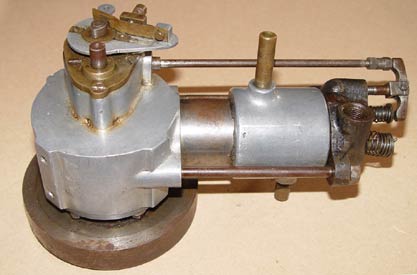
Although steam was the predominant motive power in model boats in the late 19th Century it was not long after the development of the internal combustion engine that these were being experimented with in the model boat world. Initially their size and weight proved an obstacle, especially with the equally large and heavy electrical accessories and crude fuel systems. It was not long however before this new type of power unit was making a significant impact, both in the hands of the amateur enthusiast and the fledgling commercial manufacturers, many who still remain well known over a century later. Discoveries and new material over the last decade has enabled a more detailed appraisal of the people and companies involved.
Between Mr Otto’s invention in 1876 and 1905, most of the elements of the internal combustion engine that we recognise today had been introduced and several companies that would provide engines to the ever growing market were established. Whitney came into being around 1878 and Economic Electric ten or so years later. Mr Bond opened his shop in Euston Road in 1902 and a Mr J A Prestwich started advertising engines using his initials about the same time. However E. Gray and son predated them all having been established way back in 1822. In 1905 the Model Engineer embraced the arrival of the IC engine by the Model Steamer Competition becoming the Model Speedboat Competition although with a great deal of spluttering from certain areas of the country where steam held sway. This followed the lead of the French who had already acknowledged the ‘explosion engine’ in their Branger cup races. Indeed the organisers of this event in 1905 commented ‘who knows, we might even see an international model boat race’.
The first notable success in the Speedboat Competition for an IC motor was in 1906 when the Arkell brothers finished second in Class A with their home built motor in Moraima. The following year W.J. Smith who was to become a well-known supplier of engines described his first IC motor, which he had converted from a German toy gas engine of about 14cc. Moraima with its horizontal 50cc motor was again successful in the 1907 SBC also setting a new outright record of 9.7mph, while in the Branger Cup, Girard VI and Diabolo both featured vertical ‘explosion’ motors.
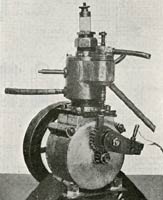 |
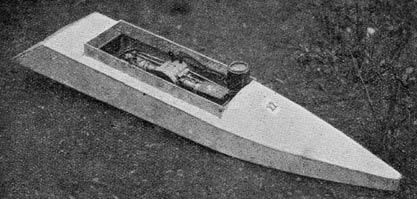 |
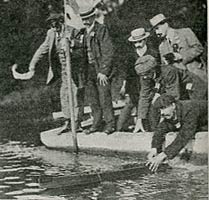 |
| Smith's 1907 engine | Mr Mill's Stentor III, circular course winner 1912 | Smith and Belvedere 1908 |
The Wembley Regatta of 1908 would prove something of a landmark for the IC motor and introduce another name that would be very influential in the commercial production of these engines, that of F.N. Sharp who finished second with ‘Varuna’. The Arkells won the event but they would remain amateur builders throughout their careers, whilst W.J. Smith and his boat ‘Belvedere’ were third. The Model Engineer remarked that ‘petrol reigned supreme’, which was a bit premature as flash steamer boats regained the record the same year and held it until 1936.
By now there were many small petrol motors about, but these were primarily intended for the burgeoning motorcycle market. A Leslie Lambert from Brockley advertised a V twin that weighed just 10lbs while the ‘Rubicon’ petrol motor was claimed to be ‘specially designed for model boats, but nothing further is known of either of these motors. The following year saw another famous name entering the market, Stuart Turner with a small two-stroke ‘boat motor’. There is more than a suspicion that the castings for these became the basis for a number of amateur built four strokes, including those of Fred Westmoreland.
|
|
W.J. Smith, now trading as the grandly titled ‘Belvedere Model Petrol Motor Manufacturing Company’ advertised 3 versions of his engine, available either as parts to machine, machined parts ready to assemble or finished and ready to run. In 1910 one of the longest-lived of all the motors was introduced, the Stuart AE, which shared several design features with the Belvedere and others. The overhead valve layout with mechanically operated exhaust and atmospheric inlet was by now universal and the AE differed from their previous motor in having a separate cylinder that was clamped to the crankcase by two long bolts through the cylinder head. |
The motor was available in four versions, two air cooled and two water cooled, either as a 25cc single cylinder intended for vertical mounting or a 50cc opposed twin for horizontal mounting. Up to this point, the majority of motors were intended for horizontal mounting with the cylinder axis along the boat though some had the crank vertical and used bevel gears to drive the prop shaft while others had the crank across the boat and used chains or gears and transfer cases to drive the propellers. Vertical mounting was so much simpler as the drive could be taken directly from the crankshaft, although it led to a very top heavy boat.
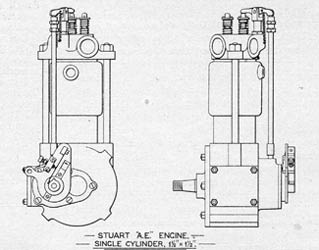 |
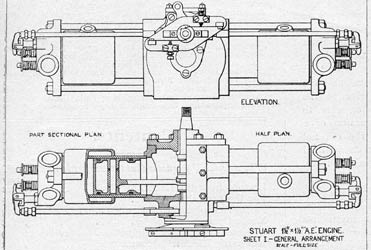 |
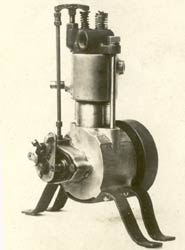 |
The early AE motors had a one-piece crankcase casting with a cover plate on the drive side, similar to their two-stroke and the Belvedere, with a basic contact breaker on the end of the camshaft. It was a relatively simple modification for the enthusiastic owner to extend the cam box and add another cam to the single cylinder motor to allow the inlet valve to be mechanically operated as well. Stuart eventually redesigned the motor completely to accomplish this, using a much more complex and substantial casting and changing to a gear driven side camshaft, with a motorcycle style timing case. Strangely, the cylinder head was still held down with two long bolts into the crankcase but with the head sandwiched between the cylinder and the rocker support.
|
For the twin the change also necessitated an entirely new and equally complex, split crankcase casting. The cylinder capacity was also increased to 30cc to meet the A class limit making the twin 60cc. Several single cylinder motors are known to exist in both forms, but the twin, which was further refined by the addition of an enclosed contact breaker is exceedingly rare, although the AE remained in the Stuart Turner catalogue for many years. |
|
|
|
Another name that came to the fore in 1910 was a competitor in the Model Speed Boat Competition of that year F.W Mills with his boat ‘Stentor II’. He also started to produce motors commercially under the name Stentor although they were so similar in design to the Belvedere range that there is some question as to whether they might have all originated from a single source. They were advertised in Model Engineer for a while but seemed to have only been in existence for a short time. It was however a competitor from the 1908 competition who would have the most significant input into the designing and running of small four strokes for the next twenty or so years and that was F.N Sharp. |
Sharp was a mechanical engineer from York Road in Wandsworth who raced hydroplanes very successfully well into the 1930s but never produced motors commercially, although he did supply numerous example to other hydro competitors. He was however responsible for the design of many examples from a variety of different companies.
|
It is believed that that wonderful emporium of all things model, mechanical and electrical, Gamages, marketed the first of his designs to appear. In 1910 Model Engineer noted that they were producing a motor specifically designed for model boats. This early illustration shows a single cylinder horizontal motor with mounting feet cast on to the bottom of the crankcase that would have required some sort of plate or frame to bolt it to. |
|
|
The advert shows the motor cost £7-12-6 or a set of castings were available for just 25/- |
|
|
|
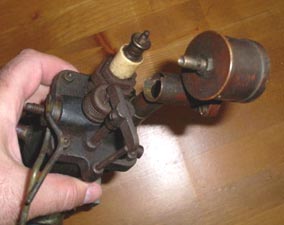 |
Previously, many of the horizontal motors had extension plates cast into either side of the crankcase. The Gamages motor had features that were to appear on all of Sharp’s subsequent designs and own engines, a round timing cover enclosing the camshaft and followers and a cylinder head with a square flange held down by four long bolts into the crankcase rather than the two of the competitors motors. Again, the exhaust valve was mechanically operated with an automatic inlet.
Oddly though, Gamages were also offering the ‘Stentor’ alongside their own motor in 1913 with considerable prominence given to the racing success of Mr Mills’ engine quoting eleven first prizes since 1910.
|
|
With cast iron cylinders and the very large flywheels required to keep these motors turning over they were no lightweights, a bare AE single or the Gamage's motor weighing in at just under 8lbs. Add to this the accumulators, coils in their wonderfully crafted wooden boxes and the surface fuel evaporators there would probably be no weight advantage over the flash steam boats. It was not until 1936 that the four strokes would challenge the steamers for outright speed, but by then the designs were more sophisticated and all produced by enthusiasts. Left: Designed and built by Fred Westmoreland and claimed to be the smallest petrol motor in the world. Sold to Gamages |
|
Following the First War the commercial development of the model four-stroke was relatively stagnant. W J Smith had emigrated, although his company did survive for just a few years more. Bond’s produced a 18cc motor similar to others that were available at the time with overhead exhaust vales and atmospheric induction valve, but little more was seen of this. Fred Westmoreland’s son in law Charles Lutz marketed a motor in 1920 called the Victoria, which was almost identical to the Stentor. Indeed, unless the name is clearly cast in or there is some other clearly identifiable feature, it is exceedingly difficult at this distance to ascribe any of these early motors to a particular manufacturer. |
|
Further confusion was added with the launch by Whitney, also in Clerkenwell, of a set of petrol engine castings around the same time. This engine was identical in every respect to one built by Fred Westmoreland around 1913/14 apart from the ‘Whitney’ name cast into the cylinder.
|
|
Again, this motor seems to have had its genesis with the Stuart monoblock two-stroke engine and it is known that Westmoreland had one of his aero engines designs built and marketed by Gamage’s, so it is possible that the ‘Whitney’ boat engine was one of his as well? The final piece of evidence that many of these motors may have had the same origins is a ‘Belvedere’ that is again identical to the Whitney and the Westmoreland motor, but has ‘Belevedere’ cast into the crankcase cover. Each also share the same bore and stroke at 1-3/16" making the capacity around 21cc and each has a distinctive round plate cylinder head with a vertical spark plug. |
It was not until the mid 20s that the first of what were to become the most common of all motors made an appearance. Economic Electric offered parts and castings for a motor designed by Sharp that has since become generically known as a ‘Grayson’. The crankcase was now split vertically, with lugs for vertical mounting, and a distinctive, removable, circular cam box that incorporated the cam followers for the inlet and exhaust valves that were now both mechanically operated. This cam box can either be brass, or aluminium, depending on the supplier of the motor. If it is brass then it is probably a Gray’s derivative. The cylinder head had a square base for the four hold down studs with the two vertical valves operated by rockers supported on a removable stand. Inlet and exhaust ports were straight out either side of the engine and across the cylinder unlike motorcycle practice. The inlet system comprised a long tube that came down the side of the engine with the fuel and air control at the bottom.
|
|
|
|
As with the earlier generation of engines, to thoroughly confuse matters, an identical motor was available from Gamages, and E Gray of Clerkenwell Road as the ‘Grayson’ with the design attributed to F.N. Sharp. Far left: Gamages version From these illustrations it is impossible to distinguish between the Gamages and Bond's offering. |
Helpfully, the genuine Graysons have the name embossed on the conrods, but this is not too much help without taking the motors apart. A similar model even appeared in the Bonds Catalogue in 1930 advertised as the ‘Super’ boat engine. Not only was the price identical, but with the exception of the carburettor and the cylinder fins, so were the engines, even to the quoted bore and stroke at 1-¼ inches. Mr Sharp had won a Bronze Medal in the 1930 ME Speedboat competition with one of these engines in his boat ‘Mona’ which had attained 27mph and therein could lay the background to this motor with the multiple identities, an early example of badge engineering perhaps? Gray’s helpfully quote the weight of the Grayson in their catalogue showing how the new breed of engines were significantly lighter than their predecessors. The cast iron version weighed in at 4lb 6ozs and the magnesium alloy one at 3lb 8ozs.
|
|
|
Bonds’ o’ Euston Road is an evocative name to anyone involved in modelling as they operated from the same premises in Euston Road London from Edwardian days until the move to Sussex in the latter days of the century.
|
Even in the late 60s a visit to the upstairs trade counter was like a step into a more gentle age, now only to be found in ‘theme’ museums. Bond’s was a ‘one stop’ shop for all model-engineering needs, and from the earliest days of hydroplane racing they supplied castings and parts to customers own requirements and for published designs.
|
By the mid 20s it seemed appropriate that they should market a suitable engine of their own and so in 1926, Bonds’ designer Mr S.W. Phillips produced the drawings for a marine engine called the "BONZONE". With a bore of 1-1/8th and stroke of 1-3/8th the capacity was approximately 25cc. The name was a word play to indicate that this was entirely a Bonds’ engine rather than to someone else’s design. As can be seen from the illustrations, the engine was a basic OHV four stroke with a vertically split aluminium crankcase and a cast iron barrel, available either with a copper water jacket or shrunk-on aluminium cooling fins. The finned head was of gunmetal with valves inclined at 75 degrees. Unlike all the designs so far described the camshaft was across the axis of the engine, connected to the crankshaft with 2:1 skew gears. Lubrication was intended to be via an oil pump on the timing case driving off the end of the crankshaft. |
|
|
|
Until such time as an oil pump could be produced the cam and tappets ran in an oil bath, with the main and big end bearings relying on ‘splash’ lubrication. The camshaft was extended through both sides of the timing case and a standard contact breaker assembly could be fitted to one of these extensions. It was not until late 1928 that Bonds’ made castings available for the engine, priced at £3 for the set, but without the oil pump and carb, which were not yet ready. By March 1929 it was possible to buy all the parts to build the engine at a lower price of £2.15.0 (£2.75) or a finished engine that could be yours for £12, unfortunately still without a carb or any ignition system. |
The carb castings became available in June for slightly less than £1 and included a genuine ‘AMAL’ float. The finished carb would allow the engine to be "throttled down to a tick over or immediately accelerated". 1/8th of a horsepower at 2000 rpm was claimed for the "BONZONE" with maximum revs up to 6000 which, given the size and weight of the flywheel, would be impressive to say the least.
|
Strangely, in the same month that the last items for the "BONZONE" became available, Bond’s announced a new engine, billed as ‘the latest petrol engine’ which they were able to place on the market at a very cheap price’. For £6.10.0 you could have a ready to run 25cc OHV four-stroke motor, almost half the price of a "BONZONE", a Grayson by any other name, although the Gamages version was more expensive at 7 guineas. By 1931 the "BONZONE" had vanished from the Bond’s catalogue to be replaced by the ‘New’ Simplex. |
|
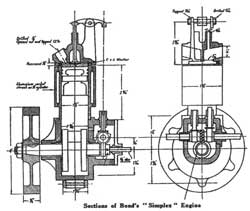 |
The crankcase and cam drive were the same as used on the earlier engine, but what had changed was the crankshaft, which now gave a stroke of 1-¼". More noticeably, the cylinder barrel, available with 1-¼ bore for 25cc or 1-5/16th to give a nominal 30cc, now had a shrunk on alloy water jacket or shrunk on aluminium cooling fins of much smaller diameter. The most radical change, and probably not for the better was to the cylinder head. Although now in cast iron rather than bronze, the angled valves were replaced with vertical ones, which necessitated the domed piston being discarded and replaced with a flat topped one, almost certainly for cheapness. |
The quoted power was now 3/8th bhp at 4000rpm with 6000rpm as maximum so it offered no real advantage over the "BONZONE". Flywheel size was reduced from the 5" of the previous engine to 4" for the Simplex, although smaller diameters were available to order. The basic Simplex cost £6-10-0 in 1931 with the carb 10/6 (52p) extra, almost half the price of the "BONZONE". With iron head and barrel, the Simplex is definitely in the ‘door stop’ category and with this in mind a ‘racing version of the engine was later produced, using Elektron magnesium alloy for the crankcases and pistons, but still with the same head. The Simplex could have been a very good engine but at less than 1 bhp in the state it was sold was only reckoned to be good enough for 15 mph in the Bond’s ready built 1 metre hydroplane hull.
|
|
However it did offer a good starting point in the 30cc class for those without workshop facilities or appropriate skills. With tuning and development, and a return to the original inclined valve head, much greater speeds could have been anticipated, and consequently both the Simplex and the Grayson were used during the 30s as the basis for many successful ‘home brewed’ engines. Left: Bond's one metre hydroplane hull built by S A C Smith of Electra Engines, fitted with a magnesium alloy Simplex and a Bond's 'racing venturi'. |
Bond’s, Gray’s, Gamages, Economic Electric and Stuart-Turner all continued to supply these pretty basic motors and many did sterling service in tethered hydroplanes and straight running boats for many years before being outclassed by the more advanced designs of the Innocent Brothers, George Noble, Stan Clifford, R E Mitchell and others. In turn, these were rendered obsolete by the advances made in two-stroke design, which oddly had been in existence for almost the same length of time as the four stroke yet took nearly fifty years to overtake them. In an ironic twist of fate, the flash steamers that had in turn been outclassed in the 1930s continued to be developed to such a stage that they are faster than all but the very best two-strokes. Only the late Vic Collins persisted with the four-stroke motor, and while it was no longer competitive in outright terms, he was determined to reach 100mph with one of these motors, which he so nearly achieved, but with an incredible number of breakages along the way.
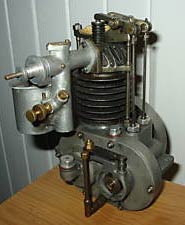 |
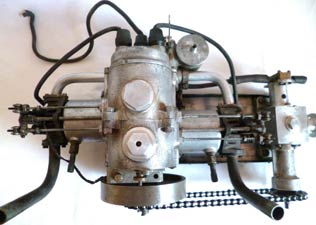 |
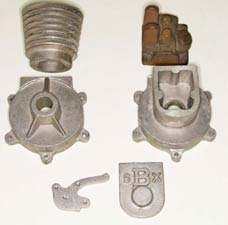 |
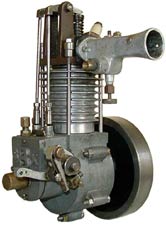 |
| Late model Stuart AE | Later version of the AE twin | Simplex castings | Elektron 'racing' Simplex |
Jim Hampton’s epic survey of commercial four-stroke designs and suppliers of castings runs to 40 different models from 1908 to the mid 1930s of which 23 motors can be confirmed through adverts and catalogues as commercially produced motors by named manufacturers. These conveniently fall into three families that can be a quick (and rough) guide to some basic identification.
Type 1. Monoblock crankcase casting with large, cast in, plates for horizontal mounting and a separate cover plate on timing side. Integral cam box orientated across the axis of the motor with a cast in push rod guide. Circular plate cylinder head with vertical valves and sparking plug. Exhaust valve mechanically operated. Almost certainly based on the Stuart Turner two-stroke motor casting. Examples: Westmoreland, Smith’s Belvedere, Whitney.
Type 2. Split crankcase casting with integral cam box cast on one side but in line with the axis of the cylinder. Plates cast into one crankcase half for horizontal mounting (except Stuart AE which had tapped bosses). Separate cylinder either bolted to crankcase or held down with long head studs. Cylinder head with horizontal inlet, exhaust and spark plug, although this is slightly angled on some models.
Examples: Mills’ Stentors, Smith’s Belvederes, Victoria. Stuart AE
Type 3. Vertically split crankcase with lugs cast in for vertical mounting. Separate circular removable cambox in brass, bronze or aluminium. Square cylinder head with two mechanically operated valves, rockers on stands or pillars, four long studs holding head and cylinder to crankcase. Ports across the axis of the motor and spark plug 20% or so off vertical. Probably all designed by F.N Sharp.
Examples: Economic Electric. Gray’s Grayson, Gamages, Bond’s Super Boat Engine.
Type 4: Uniquely Bond’s of Euston Road. Split crankcase with lugs for vertical mounting. Cast in D shaped cambox with cam across the engine. Cylinder head either bronze with radial valves (Bonzone) or iron with vertical valves as for Type 3 (Simplex).
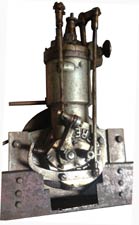 |
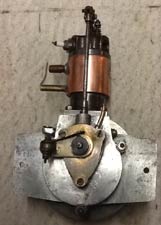 |
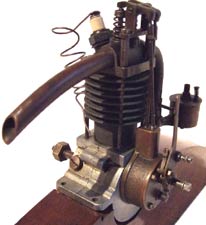 |
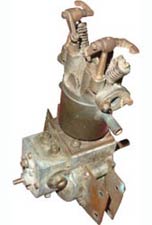 |
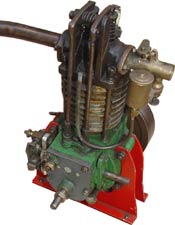 |
| Type 1 Belvedere | Type 2 Belvedere | Type 3 Sharp design (Grayson) | Type 4 Bonzone | Type 4 Simplex |
Photos: Rich Gorbutt, Bill Whitely, Paul Rippingale, Martin Gibbs, Ken Smith, Ken Lawton, Phil Procter, A King and OTW
©copyrightOTW2016